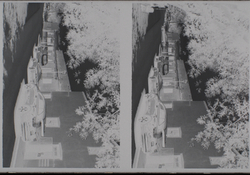dcy
Subscriber
This is Part III of my film testing saga. I feel like I'm getting better at this. I didn't make any of the mistakes I made in Parts I and II.
Recap: A while ago I took 5 rolls of film and shot a few scenes over and over so I could cut the rolls into pieces and run tests. This is the third roll.
This time we have Arista EDU Ultra 400 (aka. Fomapan 400) shot in a sunny day at EI 250 and EI 200 on my Pentax 17 half-frame camera. I cut the roll into 4 pieces and developed 3 of them in D23 stock solution at around 20°C. Inspired by a thread from @F4U , I've decided to tray straight D23 this time. The Massive Dev Chart suggests a development time of 7.5 minutes, so I decided to "bracket" that value:
1) One piece was developed for 6 min.
2) One piece was developed for 7.5 min.
3) One piece was developed for 9 min.
If the MDC is correct, the middle piece should be properly developed. From my novice point of view, they all look good to me. I like the extra shadow detail (in the trees) with EI 200. I feel that all development times show the same amount of detail in the highlights (the roof of the basilica). I would be interested to know your opinions. Without further ado, here are the results:
Start with a high-level shot of all the negatives:

Now the scans of two sample scenes:
1) D23 for 6min --- EI 250 (left) + EI 200 (right)


2) D23 for 7.5min --- EI 250 (left) + EI 200 (right)


3) D23 for 9min --- EI 250 (left) + EI 200 (right)


Recap: A while ago I took 5 rolls of film and shot a few scenes over and over so I could cut the rolls into pieces and run tests. This is the third roll.
This time we have Arista EDU Ultra 400 (aka. Fomapan 400) shot in a sunny day at EI 250 and EI 200 on my Pentax 17 half-frame camera. I cut the roll into 4 pieces and developed 3 of them in D23 stock solution at around 20°C. Inspired by a thread from @F4U , I've decided to tray straight D23 this time. The Massive Dev Chart suggests a development time of 7.5 minutes, so I decided to "bracket" that value:
1) One piece was developed for 6 min.
2) One piece was developed for 7.5 min.
3) One piece was developed for 9 min.
If the MDC is correct, the middle piece should be properly developed. From my novice point of view, they all look good to me. I like the extra shadow detail (in the trees) with EI 200. I feel that all development times show the same amount of detail in the highlights (the roof of the basilica). I would be interested to know your opinions. Without further ado, here are the results:
Start with a high-level shot of all the negatives:
Now the scans of two sample scenes:
1) D23 for 6min --- EI 250 (left) + EI 200 (right)
2) D23 for 7.5min --- EI 250 (left) + EI 200 (right)
3) D23 for 9min --- EI 250 (left) + EI 200 (right)









 )
)
 .
.

 ) / Soccer is about learning to control a bouncy ball without using your hands. Football (
) / Soccer is about learning to control a bouncy ball without using your hands. Football ( ) / Hand-Egg is about learning to throw + catch + run with a decidedly non-aerodynamic object. Speed walking is learning to do go fast without both feet leaving the ground.
) / Hand-Egg is about learning to throw + catch + run with a decidedly non-aerodynamic object. Speed walking is learning to do go fast without both feet leaving the ground.